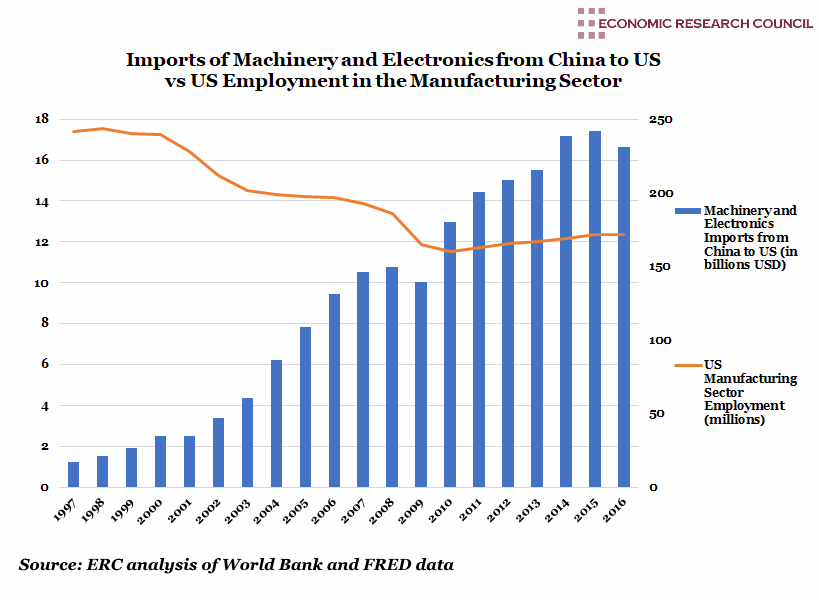Email not loading correctly? View it in your browser by clicking here.
Imports of Electronics from China to US
vs
US Manufacturing Employment
Over the past 20 years, the Chinese imports to the US have increased in value every year, bar two (in 2009, a result of the recession, and in 2016). The value of imports from China has increased by approximately 11.6% on average each year, but the proportion of this that machinery and electronics constitute has risen more quickly, by an average of 41%. In 1997, the US imported $65.8 billion worth of goods from China, with machinery and electronics making up 26% of this total. This total has increased significantly to $481.4 billion in 2016, machinery and electronics constituting almost a half of this. In the background, US employment in the manufacturing sector has contracted over the same period, by 5 million from 17.4 million to 12.4 million. Manufacturing employment took a large hit during the recession, and has plateaued in the 7 years since 2009. Although Trump has been very robust in linking the increase in Chinese imports to the deterioration of US manufacturing sector employment, the correlation is not definitive.
What does the chart show?
The chart shows the change in value of US machinery and electronics imports from China versus employment levels in the US manufacturing sector over the past 20 years. The blue bars display the amount of US imports of machinery and electronics in billions USD at current value measured against the right hand axis. The orange line shows the annual employment rate in millions in the US manufacturing sector and is measured against the left hand axis.
Why is the chart interesting?
President Trump’s tariffs on Chinese goods, much vaunted on the campaign trail, were implemented in January 2018. Last week saw the introduction of a new 25% levy on Chinese goods worth $34 billion, accompanied by further threats of 10% tariff on Chinese imports to the US worth $200 billion. Imports from China into the USA have increased more than sixfold in the last twenty years, with the US trade deficit with China currently at $336 billion. ‘Made in China 2025’, the Chinese government drive to dominate the global market in 10 sectors, would appear to stand in contention with Trump’s ‘America First’ policy.
Trump’s trade deficit reduction strategy neglects to address other headwinds faced by the US manufacturing industry, for example relatively higher wages and US firms’ failure to increase productivity through the adoption of new technologies. Many technology experts in the US, including the National Advisory Committee on Semiconductors lament that the US is no longer at the forefront of technology innovation.
Machinery and electronics as a proportion of total US imports from China have increased dramatically in the two decades shown, from 26% in 1997 to 48% in 2016. Although this increase reflects China’s shift towards the manufacture of high-technology, high-value goods, research has shown that 87% of electronics products now subject to Trump’s tariffs, are produced by multinationals and via joint ventures rather than Chinese firms. Indeed, many economists have argued the tariffs could do more harm than good, by increasing the cost of living for many Americans.
Trump has compared his trade policy to Ronald Reagan’s in the 1980s, when Reagan placed high tariffs on Japanese goods. However, Reagan’s policy failed to reduce the trade deficit with Japan, as decreased demand for Japanese computing equipment devalued the yen, making tariff-free Japanese products far more appealing.
Were Trump’s tariffs implemented a decade ago, their effect on China would have been far more profound. In 2007, 35% of Chinese GDP derived from exports, whereas in 2017 it has fallen to 18.5%. The United States receive 19% of all Chinese exports, but China is far less dependent on its export market now as burgeoning domestic consumption has risen to half of GDP and 78% of its Q1 growth this year.
However Chinese telecommunications firm ZTE’s recent dealings with Iran in contravention of US sanctions has led the US to impose a ban on the company, prohibiting it from buying from American suppliers for seven-years. This combined with the new tariffs will no doubt have an impact on China’s economy and a direct effect on the sectors contributing to the ‘Made in China 2025’ program, particularly the high-tech industry. Whether US consumers will shift their spending in line with their government’s aims is uncertain.
Please join us at our next event :
'Egalitarian Capitalism' with Gavin Oldham
11th September 2018

Gavin Oldham is the founder of The Share Centre, having previously established Barclayshare (now Barclays Stockbrokers) for Barclays Bank. Gavin plays an active role in business affairs and is a regular contributor to radio and TV. He received the Editor’s award for services to private investors from the FT/investors Chronicle in 2013. In 2005 he founded The Share Foundation and in 2014 founded Share Radio Limited. He is managing director of both those organisations and also an elective lay member of the General Synod, a Church Commissioner and a member of its Assets Committee.
Royal Overseas League, St James’s Street, SW1A 1LR. 6.30pm – 8pm.
Non-members can book Early Bird tickets here for £15 (£10 for students). Members can reserve their free place by emailing us on info@ercouncil.org .
*SAVE THE DATE*
Annual 'Your Property: Boom or Bust?' Event
23rd October 2018
For more information on these and other events visit the ERC website: www.ercouncil.org
If you're interested in becoming a member of the ERC, please click here
To contact the Economic Research Council:
info@ercouncil.org
Economic Research Council, 5 Albany Courtyard, London, W1J 0HF
Tel: 020 3793 7159

